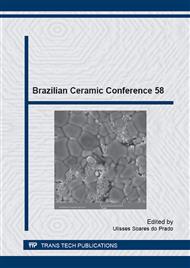p.355
p.361
p.367
p.373
p.378
p.384
p.393
p.399
p.405
Study of the Influence of Eu3+ Ions in the Bandgap of K2NdNb5O15 Nanopowders
Abstract:
Ferroelectric semiconductors oxides with tetragonal tungsten bronze TTB-type structure doped with rare earth ions have been investigated in recent years due their promising optical properties. K2Nd(1-x)EuxNb5O15 nanopowders, where x = 0, 0.0025, 0.025, 0.05 and 0.1 were synthesized by the modified polyol method and characterized by X-ray diffraction and diffuse reflectance spectroscopy UV-Vis. Single phase and crystalline powders of tetragonal symmetry with non-centrosymmetric space group P4bm were obtained. The diffuse reflectance spectra were similar to the profile of a semiconductor material with the presence of thin transitions of Eu3+ in europium-doped K2NdNb5O15, as well as the transitions of Nd3+. The method of Kubelka-Munk was used for the estimation of bandgap energy. The values around 3.7 eV showed small variation with the concentration of Eu3+ ions in the K2NdNb5O15 host structure. The transitions were identified as direct ones type.
Info:
Periodical:
Pages:
378-383
Citation:
Online since:
June 2015
Keywords:
Price:
Сopyright:
© 2015 Trans Tech Publications Ltd. All Rights Reserved
Share:
Citation:


